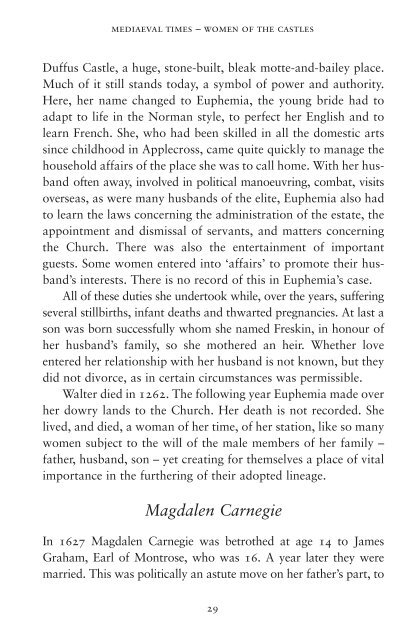Women of the Highlands by Katharine Stewart sampler
What was the crime of the last wich burnt in the Highlands? Which Jacobite lady led men to war while her Hanoverian husband stayed at home? Who were the first Highland women to be recorded in history? And how have wome's lives changed since medieval times? Katharine Stewart takes us to the heart of the Highlands in her history of the women who shaped this land and handed down the legends which have provided a rich vein of material for generations. From the women of the shielings to ladies at court, from bards to conservationists, authors to folk-singers, Women of the Highlands examines how the culture of the Highlands was created and passed down through the centuries, and how the tradition is continuing today.
What was the crime of the last wich burnt in the Highlands?
Which Jacobite lady led men to war while her Hanoverian husband stayed at home?
Who were the first Highland women to be recorded in history?
And how have wome's lives changed since medieval times?
Katharine Stewart takes us to the heart of the Highlands in her history of the women who shaped this land and handed down the legends which have provided a rich vein of material for generations. From the women of the shielings to ladies at court, from bards to conservationists, authors to folk-singers, Women of the Highlands examines how the culture of the Highlands was created and passed down through the centuries, and how the tradition is continuing today.
Create successful ePaper yourself
Turn your PDF publications into a flip-book with our unique Google optimized e-Paper software.
mediaeval times – women <strong>of</strong> <strong>the</strong> castles<br />
Duffus Castle, a huge, stone-built, bleak motte-and-bailey place.<br />
Much <strong>of</strong> it still stands today, a symbol <strong>of</strong> power and authority.<br />
Here, her name changed to Euphemia, <strong>the</strong> young bride had to<br />
adapt to life in <strong>the</strong> Norman style, to perfect her English and to<br />
learn French. She, who had been skilled in all <strong>the</strong> domestic arts<br />
since childhood in Applecross, came quite quickly to manage <strong>the</strong><br />
household affairs <strong>of</strong> <strong>the</strong> place she was to call home. With her husband<br />
<strong>of</strong>ten away, involved in political manoeuvring, combat, visits<br />
overseas, as were many husbands <strong>of</strong> <strong>the</strong> elite, Euphemia also had<br />
to learn <strong>the</strong> laws concerning <strong>the</strong> administration <strong>of</strong> <strong>the</strong> estate, <strong>the</strong><br />
appointment and dismissal <strong>of</strong> servants, and matters concerning<br />
<strong>the</strong> Church. There was also <strong>the</strong> entertainment <strong>of</strong> important<br />
guests. Some women entered into ‘affairs’ to promote <strong>the</strong>ir husband’s<br />
interests. There is no record <strong>of</strong> this in Euphemia’s case.<br />
All <strong>of</strong> <strong>the</strong>se duties she undertook while, over <strong>the</strong> years, suffering<br />
several stillbirths, infant deaths and thwarted pregnancies. At last a<br />
son was born successfully whom she named Freskin, in honour <strong>of</strong><br />
her husband’s family, so she mo<strong>the</strong>red an heir. Whe<strong>the</strong>r love<br />
entered her relationship with her husband is not known, but <strong>the</strong>y<br />
did not divorce, as in certain circumstances was permissible.<br />
Walter died in 1262. The following year Euphemia made over<br />
her dowry lands to <strong>the</strong> Church. Her death is not recorded. She<br />
lived, and died, a woman <strong>of</strong> her time, <strong>of</strong> her station, like so many<br />
women subject to <strong>the</strong> will <strong>of</strong> <strong>the</strong> male members <strong>of</strong> her family –<br />
fa<strong>the</strong>r, husband, son – yet creating for <strong>the</strong>mselves a place <strong>of</strong> vital<br />
importance in <strong>the</strong> fur<strong>the</strong>ring <strong>of</strong> <strong>the</strong>ir adopted lineage.<br />
Magdalen Carnegie<br />
In 1627 Magdalen Carnegie was betro<strong>the</strong>d at age 14 to James<br />
Graham, Earl <strong>of</strong> Montrose, who was 16. A year later <strong>the</strong>y were<br />
married. This was politically an astute move on her fa<strong>the</strong>r’s part, to<br />
29


















